Initial MBS Transport Function API examples
This tutorial describes the initial reference implementation of the MBS Transport Function (MBSTF) as specified in 3GPP TS 26.517 and 3GPP TS 29.581. You can check out the videos to see more details or follow the write-up tutorial.
Tutorial videos
Architecture
---
title: "MBSTF and associated 5G NFs"
config:
block:
padding: 12
useMaxWidth: true
---
block-beta
columns 9
block: g1:7
columns 7
space:3 text1["5MBS reference points"] space:3
space:4 NEF["NEF"]:3
space:7
AMF["AMF"] space SMF["SMF"] space MBSMF["MB-SMF"] space MBSF["MBSF"]
space:7
RAN["NG-RAN"] space UPF["UPF"] space MBUPF["MB-UPF"] space MBSTF["MBSTF"]
invis1((" ")) space:3 invis2((" ")) space:2
end
space AP["MBS Application Provider\n(AF/AS)"]
NEF-- "N29mb" ---MBSMF
NEF-- "Nmb5" ---MBSF
MBSF-- "Nmb1" ---MBSMF
MBSMF-- "N16mb" ---SMF
MBSF-- "Nmb2" ---MBSTF
MBSMF-- "N4mb" ---MBUPF
MBSTF-- "Nmb9" ---MBUPF
MBUPF-- "N19mb" ---UPF
SMF-- "N4" ---UPF
SMF-- "N11" ---AMF
UPF-- "N3" ---RAN
AMF-- "N2" ---RAN
MBUPF---invis2
invis2-- "N3mb" ---invis1
invis1---RAN
AP-- "N33" ---NEF
AP-- "Nmb10" ---MBSF
AP-- "Nmb8" ---MBSTF
style invis1 fill: #0000, stroke: #0000, color: #0000
style invis2 fill: #0000, stroke: #0000, color: #0000
style text1 fill: #0000, stroke: #0000
Prerequisites
This tutorial assumes that you have cloned and built the rt-mbs-transport-function repository.
Description
In this tutorial we will configure the MBSTF with a variety of MBS Distribution Session types. This tutorial will also cover optional integration with the MB-SMF and MB-UPF.
You should follow the build instructions for the rt-mbs-transport-function repository found in the README.md on the repository main page.
For these examples you will also need Wireshark, to view the results, and either build the 5G-MAG version of Open5GS with UDP tunnelling or the install the netcat package to fake an MB-UPF UDP tunnel.
Step 1a: (Optional) Create an MBS Session on the MB-UPF with UDP tunnel
This is the first option for creating a UDP tunnel for multicast distribution. This implements the following highlighted steps from creating an MBS User Service.
---
title: "MBS User Service Creation: MBS Session creation on the MB-SMF"
config:
sequence:
showSequenceNumbers: true
---
sequenceDiagram
participant MBUPF as MB-UPF
participant MBSMF as MB-SMF
participant MBSF
participant AP as AF/AS
activate MBSMF
activate MBUPF
activate MBSF
AP ->> MBSF: Create MBS User Service
MBSF -->> AP: MBS User Service created
AP ->> MBSF: Add MBS User Data Ingest<br/>Session to MBS User Service
rect rgb(160, 255, 160)
MBSF ->> MBSMF: Add MBS Session,<br/>and request an Nmb9 ingress tunnel
MBSMF ->> MBUPF: Set up Multicast/Broadcast service<br/>and create an Nmb9 ingress tunnel
MBUPF -->> MBSMF: Success<br/>and Nmb9 ingress tunnel details
MBSMF -->> MBSF: MBS Session created and Nmb9 tunnel details
end
deactivate MBSF
deactivate MBSMF
deactivate MBUPF
To use this you will need a 5G Core with an MB-UPF and an MB-SMF that are both capable of allocating an ingress tunnel at reference point Nmb9. An example of such a 5G Core can be found in the 5G-MAG/open5gs repository in the 5mbs branch.
Start the NRF, SCP, AMF, MB-SMF and MB-UPF.
git clone --depth 1 --recurse-submodules -b 5mbs https://github.com/5G-MAG/open5gs.git ~/open5gs
cd ~/open5gs
meson setup --prefix=$PWD/install build
ninja -C build install
LD_LIBRARY_PATH="$PWD/install/lib64:$PWD/install/lib" export LD_LIBRARY_PATH
install/bin/open5gs-nrfd > nrf.log 2>&1 &
install/bin/open5gs-scpd > scp.log 2>&1 &
install/bin/open5gs-amfd > amf.log 2>&1 &
install/bin/open5gs-smfd > smf.log 2>&1 &
sudo -E install/bin/open5gs-upfd > upf.log 2>&1 &
Copy this Nmbsmf_MBSSession CreateReqData JSON object into a file called create-mbs-session.json:
{
"mbsSession": {
"mbsSessionId": {
"ssm": {
"sourceIpAddr": {
"ipv4Addr": "127.0.0.1"
},
"destIpAddr": {
"ipv4Addr": "232.0.0.1"
}
}
},
"tmgiAllocReq": true,
"serviceType": "MULTICAST",
"ingressTunAddrReq": true,
"activityStatus": "ACTIVE",
"anyUeInd": true
}
}
Then we send this file to the MB-SMF to request that it creates a new multicast MBS Session (sequence steps 4 to 7):
curl --http2-prior-knowledge -H 'Content-Type: application/json' --data @create-mbs-session.json http://127.0.0.4:7777/nmbsmf-mbssession/v1/mbs-sessions
The response will look similar to this:
{
"mbsSession": {
"mbsSessionId": {
"ssm": {
"sourceIpAddr": {
"ipv4Addr": "127.0.0.1"
},
"destIpAddr": {
"ipv4Addr": "232.0.0.1"
}
}
},
"tmgi": {
"mbsServiceId": "D8AA35",
"plmnId": {
"mcc": "000",
"mnc": "000"
}
},
"serviceType": "MULTICAST",
"ingressTunAddr": [
{
"ipv4Addr": "127.0.0.7",
"portNumber": 42497
}
],
"ssm": {
"sourceIpAddr": {
"ipv4Addr": "127.0.0.1"
},
"destIpAddr": {
"ipv4Addr": "232.0.0.1"
}
}
}
}
It contains the UDP tunnel details at JSON path .mbsSession.ingressTunAddr. These will need to be substituted in the .distSession.mbUpfTunAddr object in the Distribution Session JSON objects in the following steps in order to direct the output to the MB-UPF.
Step 1b: (Optional) Fake a UDP tunnel
This can be useful if you just want to inspect the output of the MBSTF in isolation. Instead of running an MBS-enabled 5G Core, you can simulate the receiving end of the UDP tunnel that would normally be provided by the MB-UPF.
For this we will need the netcat or nc command from the netcat package (nmap-ncat on RHEL based systems).
The command to create a tunnel at 127.0.0.7:5678 is:
nc -u -l 127.0.0.7 5678 > /dev/null &
Step 2: Start the mock media express server
When configured to operate in one of the pull-based object acquisition methods, the MBSTF requires an HTTP server from which to request the objects. For the purposes of these tutorials we will use a simple HTTP server based on the NodeJS Express module which has been configured to serve some simple media objects. This simulates a media server or CDN that would be provided by the MBS Application Provider (AF/AS).
You can install and run the Express mock media server directly or via Docker:
Option 1: Running the Express server outside of Docker
- Clone the rt-mbs-examples repository:
cd ~ git clone -b development https://github.com/5G-MAG/rt-mbs-examples.git - Prepare the Express server for running:
cd ~/rt-mbs-examples/express-mock-media-server npm install - Run the Express server:
cd ~/rt-mbs-examples/express-mock-media-server npm start
The mock media server is now running on TCP port 3004 and ready to serve objects for the following tutorial examples.
Option 2: Running the Express server in Docker
- Clone the rt-mbs-examples repository:
cd ~ git clone -b development https://github.com/5G-MAG/rt-mbs-examples.git - Navigate to the Docker directory:
cd ~/rt-mbs-examples/express-mock-media-server/docker - Start the Express server:
docker compose up --build
The mock media server is now running on TCP port 3004 and ready to serve objects for the following tutorial examples.
Step 3: Run the MBSTF
If the build and install instructions from rt-mbs-transport-function have been followed, then the MBSTF can be run using:
sudo /usr/local/bin/open5gs-mbstfd &
Step 4: Start and configure Wireshark to capture the encapsulated FLUTE
- Set up packet decoding:
- In the Analyze menu, select Decode As… to open the “Decode As…” dialog.
- Dissect the reference point Nmb9 unicast tunnel. If a rule does not exist for UDP with a port number matching the UDP tunnel (the
portNumbergiven for the first tunnel (ingressTunAddr) in the response in Step 1a or5678for Step 1b), then create a new rule, set the field toUDP port, set the port number to the tunnel port and set the Current decoding asIPv4. - Dissect the multicast packets carried inside the reference point Nmb9 unicast tunnel. If a rule does not exist for the UDP port
5000(the port we will use for the multicast) then create a new rule for a “UDP port”, set the port number to5000and the Current decoding toALC. - Select the Save or OK button to close the dialog. Saving will store the rules for next time Wireshark is started.
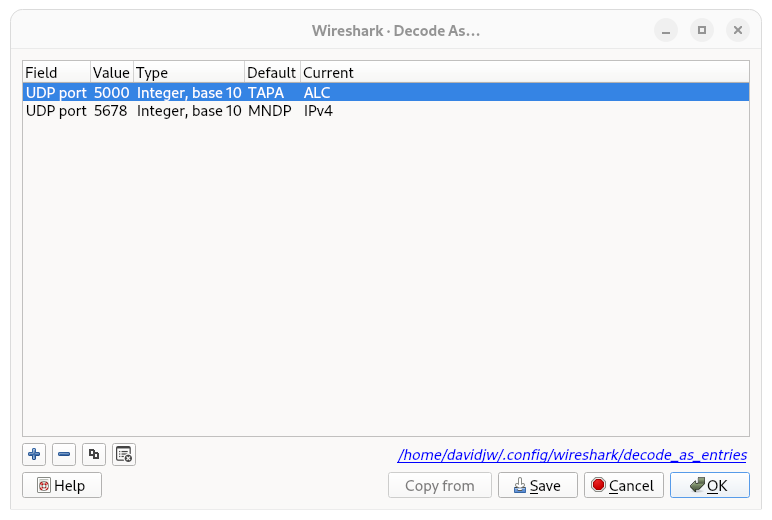
-
Select (but don’t start) the correct interface for capture. This will usually be the Ethernet interface if you used Step 1a or the local loopback (lo) interface if you are using Step 1b.
Note: If Wireshark is not showing your Ethernet interface try starting it with sudo rights:
sudo wireshark - Enter the filter expression if…:
- You followed Step 1a, enter a filter of
ip.src == <tunnel-ip-address>, where<tunnel-ip-address>is the IP address of the tunnel given in the response for 1a (ingressTunAddr). - You followed Step 1b, enter a filter of
ip.src == 127.0.0.7.
- You followed Step 1a, enter a filter of
- Then start the capture.
Step 5: Create a single shot MBS Distribution Session for pull operation
This tests the single-shot object operating mode (SINGLE) for the pull-based object acquisition method. This executes the following highlighted steps from MBS User Service provisioning using the command line to perform the actions that the MBSF would otherwise perform.
---
title: "MBS User Service Creation: PULL Single Shot Distribution Session creation on the MBSTF"
config:
themeCSS: |
.loopLine { stroke-width: 4px; stroke-dasharray: 5,5; }
sequence:
showSequenceNumbers: true
---
sequenceDiagram
participant RAN as NG-RAN
participant MBUPF as MB-UPF
participant MBSMF as MB-SMF
participant MBSTF
participant MBSF
participant AP as MBS Application Provider (AF/AS)
activate RAN
activate MBSMF
activate MBUPF
activate MBSF
activate MBSTF
AP ->> MBSF: Add MBS User Data Ingest Session<br/>to MBS User Service
MBSF ->> MBSMF: Create MBS Session<br/>and request an Nmb9 ingress tunnel
MBSMF ->> MBUPF: Set up Multicast/Broadcast service and<br/>create an Nmb9 ingress tunnel
MBUPF -->> MBSMF: Success and Nmb9 tunnel details
MBSMF -->> MBSF: MBS Session created and Nmb9 tunnel details
rect rgb(160,255,160)
MBSF ->> MBSTF: Create Distribution Session<br/>using tunnel from MB-SMF
MBSTF -->> MBSF: Distribution Session created
end
MBSF -->> AP: MBS User Data Session created
rect rgb(160,255,160)
MBSTF ->> AP: Fetch object(s) described<br/>in Distribution Session
AP -->> MBSTF: Response with object(s)
MBSTF ->> MBUPF: Package object(s) into multicast FLUTE session packets<br/>and send to Nmb9 tunnel at configured bit rate
MBUPF ->> RAN: Multicast FLUTE packets forwarded<br/>to gNodeB(s) via multicast GTP-U tunnel
end
deactivate MBSTF
deactivate MBSF
deactivate MBSMF
deactivate MBUPF
deactivate RAN
With the following processes running:
- Express server from Step 2
- the MBSTF from Step 3
- Wireshark from step 4
…perform the following actions to test a single shot distribution from PULL requested media objects.
Copy the following into a file called DistSession-PULL-request.json:
{
"distSession": {
"distSessionId": "cab87e4b-01b1-4138-9018-7d30bcb1606b",
"distSessionState": "ACTIVE",
"mbUpfTunAddr": {
"ipv4Addr": "127.0.0.7",
"portNumber": 5678
},
"upTrafficFlowInfo": {
"destIpAddr": {
"ipv4Addr": "232.0.0.1"
},
"portNumber": 5000
},
"mbr": "10 Mbps",
"objDistributionData": {
"objDistributionOperatingMode": "SINGLE",
"objAcquisitionMethod": "PULL",
"objAcquisitionIdsPull": [
"object1",
"object2",
"object3",
"object4"
],
"objIngestBaseUrl": "http://127.0.0.1:3004/",
"objDistributionBaseUrl": "http://127.0.0.2/"
}
}
}
If you are using the option to use a running MB-SMF/MB-UPF (Step 1a) then make the following changes to the JSON above:
- Change the MB-UPF tunnel IP address
distSession.mbUpfTunAddr.ipv4Addrfrom 127.0.0.7 to the destination IP address of the Nmb9 tunnel returned in the MB-SMF response (sequence step 5). - Change the MB-UPF tunnel port number
distSession.mbUpfTunAddr.portNumberfrom 5678 to the destination port number for the Nmb9 tunnel returned in the MB-SMF response (sequence step 5).
Then send the DistSession JSON object in DistSession-PULL-request.json to the MBSTF to configure it (sequence step 6):
curl --http2-prior-knowledge -H 'Content-Type: application/json' --data-binary @DistSession-PULL-request.json http://127.0.0.62:7777/nmbstf-distsession/v1/dist-sessions
The response from the MBSTF (step 7) should look like:
{
"distSession": {
"distSessionId": "cab87e4b-01b1-4138-9018-7d30bcb1606b",
"distSessionState": "ACTIVE",
"objDistributionData": {
"objDistributionOperatingMode": "SINGLE",
"objAcquisitionMethod": "PULL",
"objAcquisitionIdsPull": [
"object1",
"object2",
"object3",
"object4"
],
"objIngestBaseUrl": "http://127.0.0.1:3004/",
"objDistributionBaseUrl": "http://127.0.0.2/"
}
}
}
The Wireshark packet capture (sequence step 11) will look like:
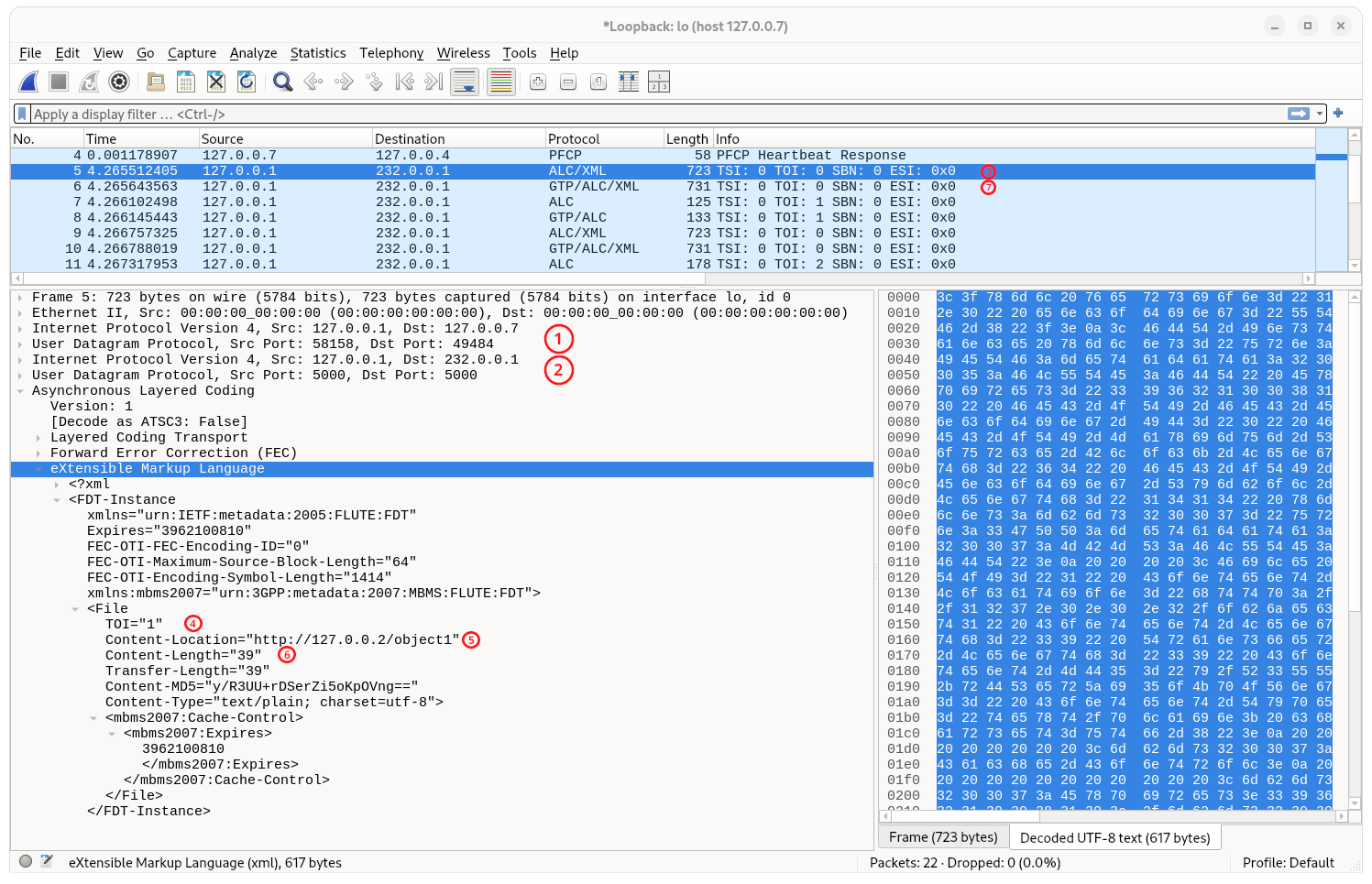
This shows the FLUTE FDT Instance File entry for the first object pulled from the Express server. Examining the packet it can be noticed that:
- There are outer IP and UDP protocol headers showing the packet is sent from 127.0.0.1:58158 to 127.0.0.7:49484 ➀ because an MB-UPF was used for this example which presented its tunnel at 127.0.0.7:49484.
- The next (inner) pair of IP and UDP headers show that this encapsulated packet is from 127.0.0.1:5000 to multicast address 232.0.0.1:5000 ➁, as requested in the DistributionSession creation request to the MBSTF.
- The packet contents are a FLUTE packet for Transport Session Identifier 0 and Transport Object Identifier 0 (” TSI: 0 TOI: 0”, from the packet summary ➂) which indicates that the transport object is the FDT Instance document. The contents of the FDT Instance document show that the FLUTE Session is currently sending a 39-byte transmission object ➅ referenced as
TOI="1"➃ with a content location of “http://127.0.0.2/object1” ➄. The “http://127.0.0.2” prefix is the one requested by the objDistributionBaseUrl field in the DistributionSession configured in the MBSTF, and has replaced the origin prefix of “http://127.0.0.1:3004” ( objIngestBaseUrl field). - The next packet contains the same multicast packet ➆ sent from the MB-UPF to the gNodeB using GTP-U tunnel encapsulation.
This next screenshot shows the FLUTE packet for TOI 1, the ingested media object object1 itself.
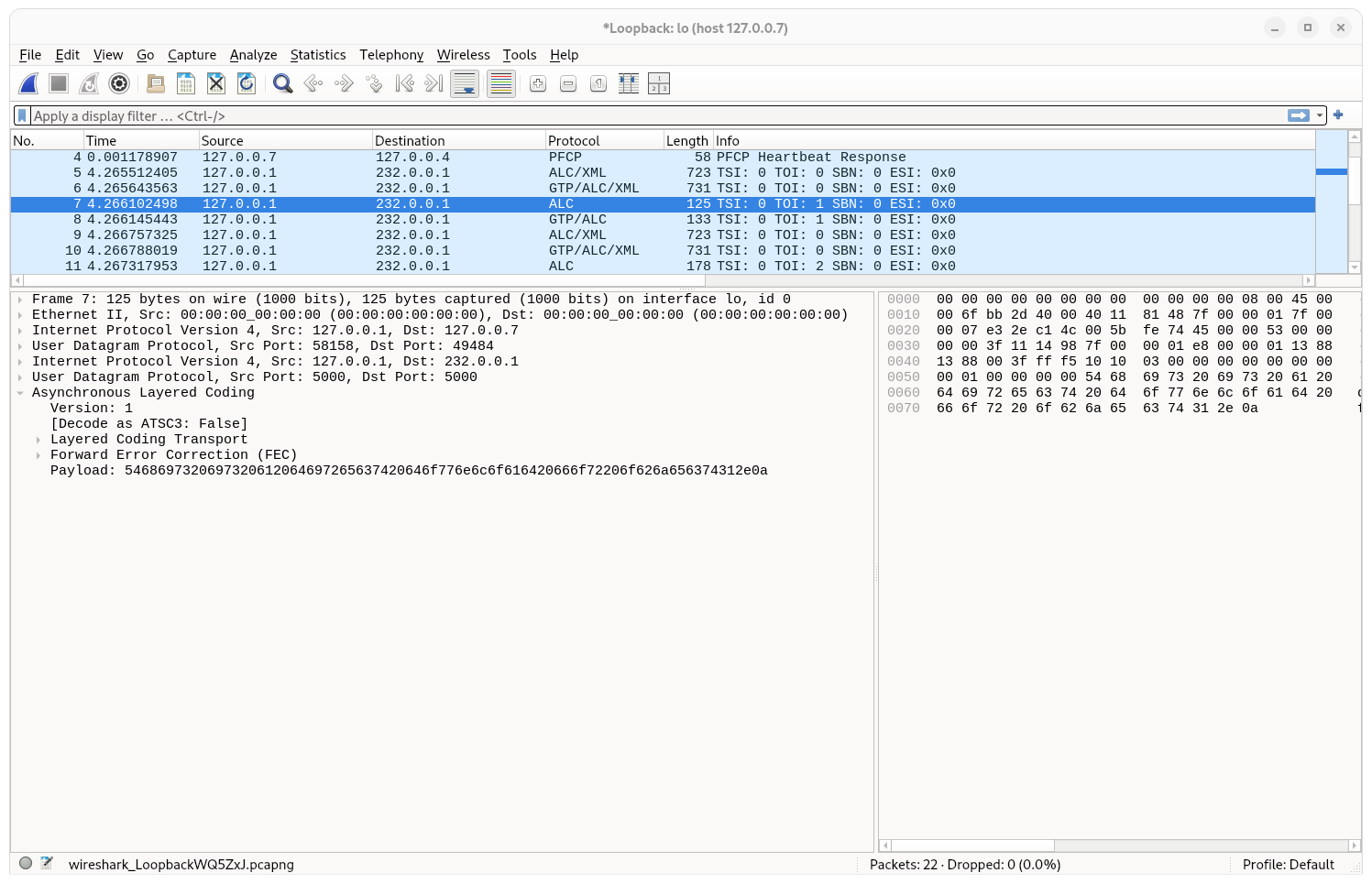
Step 6: Create a single shot MBS Distribution Session for push operation
This tests the SINGLE distribution mode for PUSHed content. This executes the following highlighted steps from MBS User Service provisioning using the command line to perform the actions that the MBSF and AP would otherwise perform.
---
title: "MBS User Service Creation: PUSH Single Shot Distribution Session creation on the MBSTF"
config:
themeCSS: |
.loopLine { stroke-width: 4px; stroke-dasharray: 5,5; }
sequence:
showSequenceNumbers: true
---
sequenceDiagram
participant RAN as NG-RAN
participant MBUPF as MB-UPF
participant MBSMF as MB-SMF
participant MBSTF
participant MBSF
participant AP as MBS Application Provider (AF/AS)
activate RAN
activate MBSMF
activate MBUPF
activate MBSF
activate MBSTF
AP ->> MBSF: Add MBS User Data Ingest<br/>Session to MBS User Service
MBSF ->> MBSMF: Create MBS Session and<br/>request an Nmb9 ingress tunnel
MBSMF ->> MBUPF: Set up Multicast/Broadcast service and<br/>create an Nmb9 ingress tunnel
MBUPF -->> MBSMF: Success and tunnel details
MBSMF -->> MBSF: MBS Session created and tunnel details
rect rgb(160, 255, 160)
MBSF ->> MBSTF: Create Distribution Session<br/>using tunnel from MB-SMF
MBSTF -->> MBSF: Distribution Session created<br/>include push service URL if requested
end
MBSF -->> AP: MBS User Data Session created,<br/>including push Service Entry Point URL, if requested
rect rgb(160, 255, 160)
AP ->> MBSTF: Push object for Distribution Session
MBSTF -->> AP: Object received OK
MBSTF ->> MBUPF: Package object(s) into multicast FLUTE session packets<br/>and send to Nmb9 tunnel at configured bit rate
MBUPF ->> RAN: Multicast FLUTE packets forwarded<br/>to gNodeB(s) via multicast GTP-U tunnel
end
deactivate MBSTF
deactivate MBSF
deactivate MBSMF
deactivate MBUPF
deactivate RAN
With the following processes running:
- the MBSTF from Step 3
- Wireshark from step 4
…perform the following actions to test a single shot distribution for PUSH delivered media objects.
Copy the following into a file called DistSession-PUSH-request.json:
{
"distSession": {
"distSessionId": "3e3dc3fb-0677-42a3-86c6-bc44e3544b0f",
"distSessionState": "ACTIVE",
"mbUpfTunAddr": {
"ipv4Addr": "127.0.0.7",
"portNumber": 5678
},
"upTrafficFlowInfo": {
"destIpAddr": {
"ipv4Addr": "232.0.0.1"
},
"portNumber": 5000
},
"mbr": "10 Mbps",
"objDistributionData": {
"objDistributionOperatingMode": "SINGLE",
"objAcquisitionMethod": "PUSH",
"objDistributionBaseUrl": "http://127.0.0.2/"
}
}
}
If you are using the option to use a running MB-SMF/MB-UPF (Step 1a) then make the following changes to the JSON above:
- Change the MB-UPF tunnel IP address
distSession.mbUpfTunAddr.ipv4Addrfrom 127.0.0.7 to the destination IP address of the Nmb9 tunnel returned in the MB-SMF response (sequence step 5). - Change the MB-UPF tunnel port number
distSession.mbUpfTunAddr.portNumberfrom 5678 to the destination port number for the Nmb9 tunnel returned in the MB-SMF response (sequence step 5).
Then send the DistSession object to the MBSTF to configure it (sequence step 6):
curl --http2-prior-knowledge -H 'Content-Type: application/json' --data-binary @DistSession-PUSH-request.json http://127.0.0.62:7777/nmbstf-distsession/v1/dist-sessions
The result (sequence step 7) should look like:
{
"distSession": {
"distSessionId": "3e3dc3fb-0677-42a3-86c6-bc44e3544b0f",
"distSessionState": "ACTIVE",
"objDistributionData": {
"objDistributionOperatingMode": "SINGLE",
"objAcquisitionMethod": "PUSH",
"objIngestBaseUrl": "http://127.0.0.1:33945/",
"objDistributionBaseUrl": "http://127.0.0.2/"
}
}
}
Take note of the objIngestBaseUrl prefix URL for pushing the media objects to, e.g.:
push_prefix_url="http://127.0.0.1:33945/"
Then we can send objects to be packaged and sent via the multicast MBS Session (sequence steps 9 and 10). For example to send the meson.build file from the rt-mbs-transport-function repository that was cloned earlier we perform an HTTP PUT of the file to a URL with the prefix we remembered earlier:
curl -H 'Content-Type: text/plain' -X PUT --data-binary @"${HOME}/rt-mbs-transport-function/meson.build" "${push_prefix_url}example/path/to/object.txt"
Once pushed, the object is packaged as FLUTE and sent to the UDP tunnel.
The wireshark capture will look something like (sequence step 11):
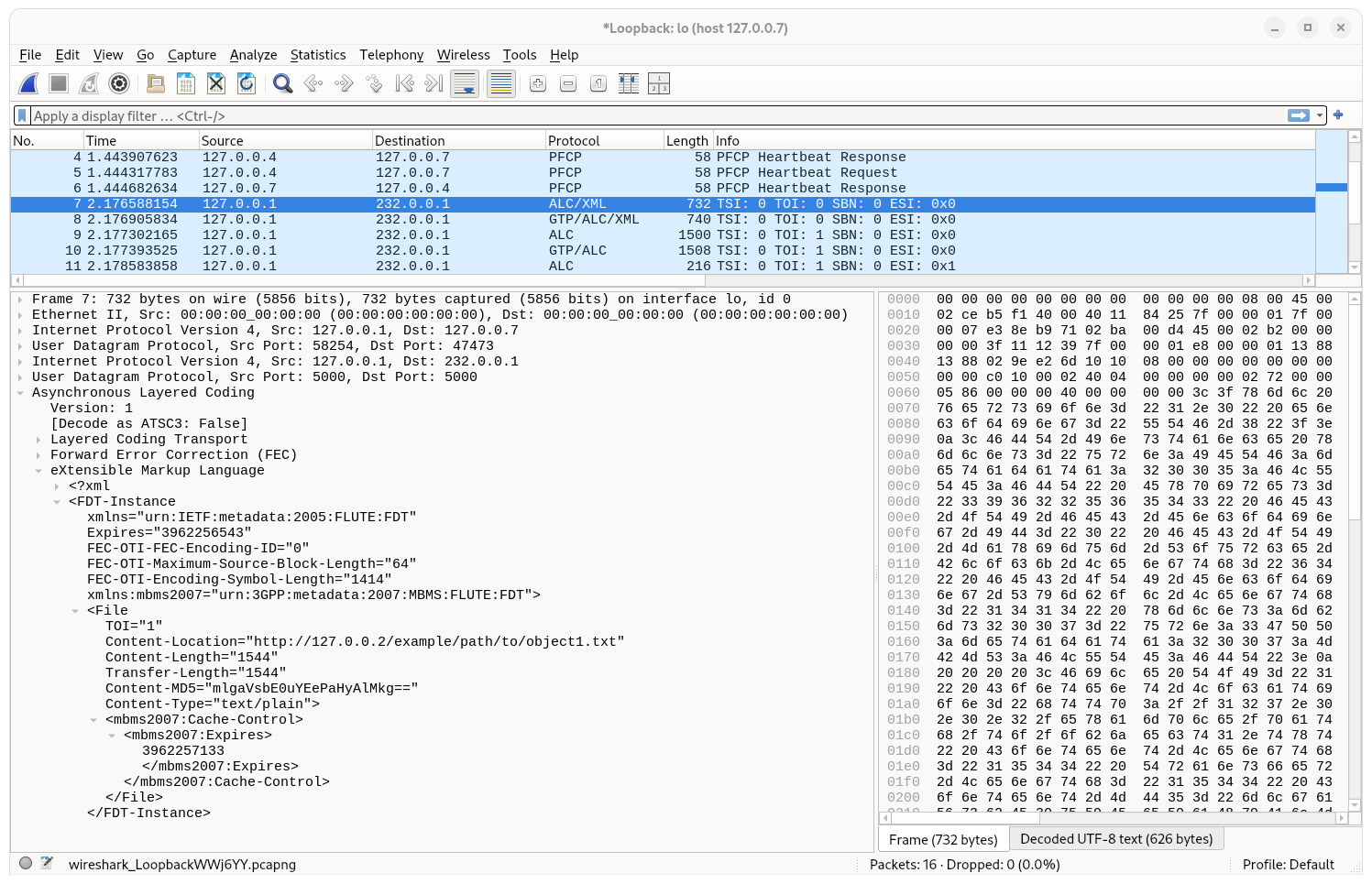
This shows the FDT for the pushed file. This is encapsulated in the same way as in step 5 of the pull-based object acquisition example. The Content-Location field in the FDT File entry shows it using the objDistributionBaseUrl followed by the path that the object was PUT to following the objIngestBaseUrl.
The FLUTE packet conveying the pushed file in TOI 1 will look something like:
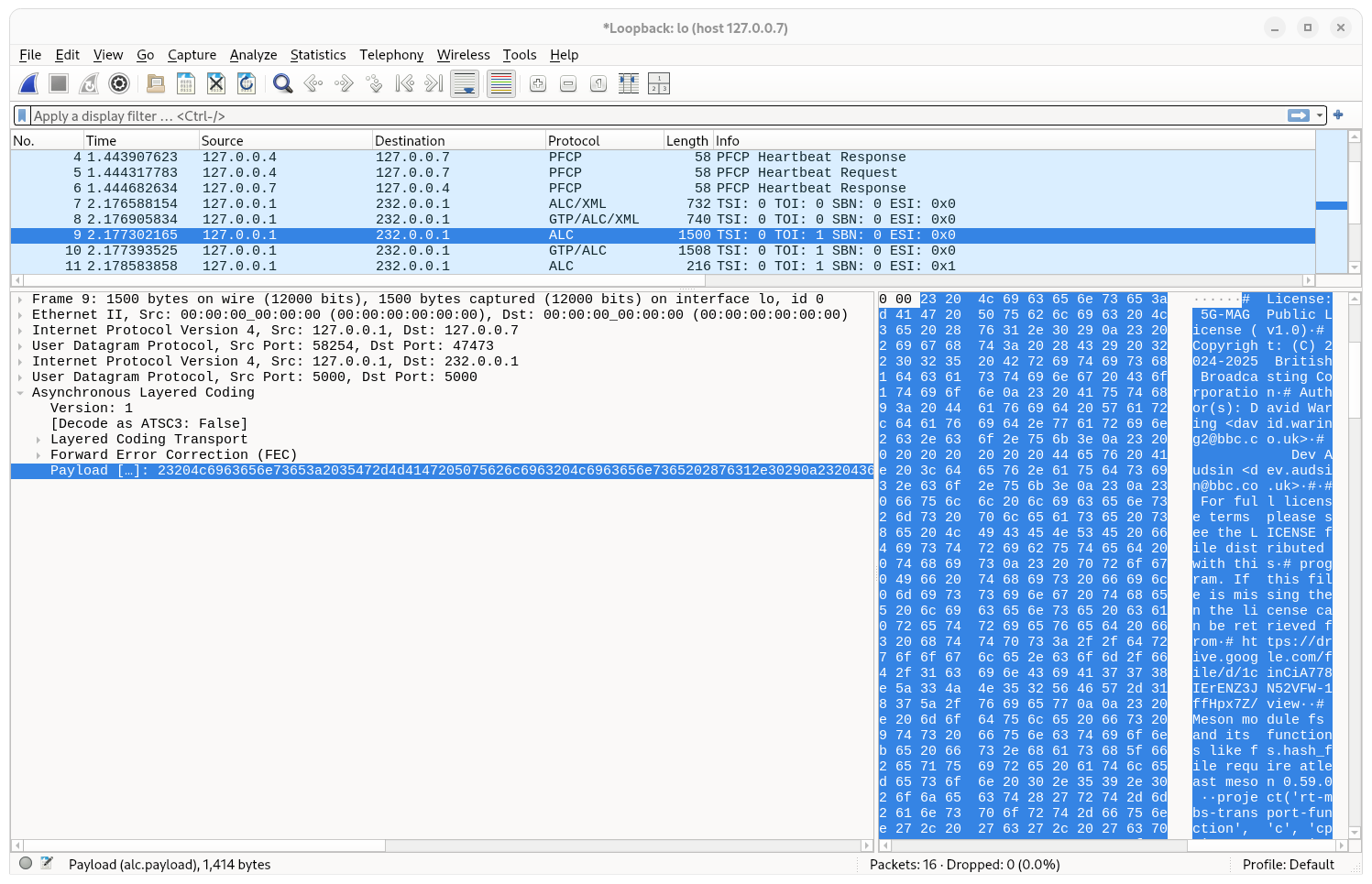
This packet (packet number 9 in the above image), containing the first bytes of the meson.build file, is followed by the rest of the file in packet number 11.
Step 7: Create a streaming MBS Distribution Session for pull operation on the DASH manifest
This tests the STREAMING distribution mode for PULLed DASH manifest file (MPD) with activity state change. This executes the following highlighted steps from MBS User Service provisioning using the command line to perform the actions that the MBSF would otherwise perform.
---
title: "MBS User Service Creation: PULL STREAMING Distribution Session creation on the MBSTF"
config:
themeCSS: |
.loopLine { stroke-width: 4px; stroke-dasharray: 5,5; }
sequence:
showSequenceNumbers: true
---
sequenceDiagram
participant RAN as NG-RAN
participant MBUPF as MB-UPF
participant MBSMF as MB-SMF
participant MBSTF
participant MBSF
participant AP as MBS Application Provider (AF/AS)
activate RAN
activate MBSMF
activate MBUPF
activate MBSF
activate MBSTF
AP ->> MBSF: Add MBS User Data Ingest<br/>Session to MBS User Service
MBSF ->> MBSMF: Create MBS Session and request Nmb9 ingress tunnel
MBSMF ->> MBUPF: Set up Multicast/Broadcast service and<br/>create an Nmb9 ingress tunnel
MBUPF -->> MBSMF: Success and Nmb9 ingress tunnel details
MBSMF -->> MBSF: MBS Session created<br/>and Nmb9 ingress tunnel details
rect rgb(160, 255, 160)
MBSF ->> MBSTF: Create Distribution Session<br/>using Nmb9 tunnel details from<br/>MB-SMF in INACTIVE state
MBSTF -->> MBSF: Distribution Session created
end
MBSF -->> AP: MBS User Data Session created
alt MBSUserDataIngSession.actPeriods has an array of TimeWindow components
par N seconds before the start<br/>of the next TimeWindow
MBSF ->> MBSTF: PATCH the DistSession to change<br/>distSessionState to ESTABLISHED
MBSTF -->> MBSF: PATCH applied
and At the start of the next TimeWindow
MBSF ->> MBSTF: PATCH the DistSession to change<br/>distSessionState to ACTIVE
MBSTF -->> MBSF: PATCH applied
and At the end of the next TimeWindow
MBSF ->> MBSTF: PATCH the DistSession to change<br/>distSessionState to INACTIVE
MBSTF -->> MBSF: PATCH applied
end
else MBSUserDataIngSession.actPeriodRepRule object has a value
par N seconds before the start<br/>of the next TimeWindow
MBSF ->> MBSTF: PATCH the DistSession to change<br/>distSessionState to ESTABLISHED
MBSTF -->> MBSF: PATCH applied
and At the start of the next TimeWindow
MBSF ->> MBSTF: PATCH the DistSession to change<br/>distSessionState to ACTIVE
MBSTF -->> MBSF: PATCH applied
and At the end of the next TimeWindow
MBSF ->> MBSTF: PATCH the DistSession to change<br/>distSessionState to INACTIVE
MBSTF -->> MBSF: PATCH applied
end
else no MBSUserDataIngSession.actPeriods or MBSUserDataIngSession.actPeriodRepRule value
AP ->> MBSF: Update MBSUserDataIngSession to change<br/>mbsDistSessionState value from INACTIVE to ACTIVE
rect rgb(160, 255, 160)
MBSF ->> MBSTF: PATCH distSession.distSessionState<br/>value to ACTIVE
MBSTF -->> MBSF: PATCH applied
end
MBSF -->> AP: MBSUserDataIngSession updated
end
rect rgb(160, 255, 160)
MBSTF ->> AP: Pull DASH manifest
AP -->> MBSTF: DASH manifest
MBSTF ->> MBUPF: DASH manifest packaged in multicast FLUTE session packets and send to tunnel at given rate
MBUPF ->> RAN: Multicast FLUTE packets<br/>forwarded to gNodeB(s) via multicast GTP-U tunnel
loop For each initialization segment in the DASH manifest
MBSTF ->> AP: Pull Initialization Segment
AP -->> MBSTF: Initialization Segment
MBSTF ->> MBUPF: Initialization Segment packaged in multicast FLUTE session packets and send to tunnel at given rate
MBUPF ->> RAN: Multicast FLUTE packets forwarded<br/>to gNodeB(s) via multicast GTP-U tunnel
end
par If the DASH manifest has a refresh period
loop If the DASH manifest has a refresh period
MBSTF ->> MBSTF: Wait for the next MPD refresh time
MBSTF ->> AP: Pull DASH manifest
AP -->> MBSTF: DASH manifest
MBSTF ->> MBUPF: Package DASH manifest into multicast FLUTE session packets<br/>and send to Nmb9 tunnel at configured bit rate
MBUPF ->> RAN: Multicast FLUTE packets forwarded<br/>to gNodeB via multicast GTP-U tunnel
loop For each initialization segment in the DASH manifest
MBSTF ->> AP: Pull Initialization Segment
AP -->> MBSTF: Initialization Segment
MBSTF ->> MBUPF: Package Initialization Segment into multicast FLUTE session packets<br/>and send to Nmb9 tunnel at configured bit rate
MBUPF ->> RAN: Multicast FLUTE packets forwarded<br/>to gNodeB(s) via multicast GTP-U tunnel
end
end
and For each Representation in the current period
loop For each Media Segment in the Representation
MBSTF ->> MBSTF: Wait for the Media Segment to become available
MBSTF ->> AP: Pull Media Segment
AP -->> MBSTF: Media Segment
MBSTF ->> MBUPF: Package Media Segment into multicast FLUTE session packets<br/>and send to Nmb9 tunnel at configured bit rate
MBUPF ->> RAN: Multicast FLUTE packets forwarded<br/>to gNodeB(s) via multicast GTP-U tunnel
end
end
end
opt no MBSUserDataIngSession.actPeriods or MBSUserDataIngSession.actPeriodRepRule value
AP ->> MBSF: Update MBSUserDataIngSession to change<br/>mbsDistSessionState value from ACTIVE to INACTIVE
rect rgb(160, 255, 160)
MBSF ->> MBSTF: PATCH DistSession.distSessState<br/>value to INACTIVE
MBSTF -->> MBSF: PATCH applied
end
MBSF -->> AP: MBSUserDataIngSession updated
end
deactivate MBSTF
deactivate MBSF
deactivate MBSMF
deactivate MBUPF
deactivate RAN
With the following processes running:
- the MBSTF from Step 3
- Wireshark from step 4
…perform the following actions to test a streaming distribution from PULL of a DASH MPD.
Copy the following into a file called DistSession-DASH-PULL-request.json:
{
"distSession": {
"distSessionId": "541ebbd2-ebf9-496b-a3b8-dcd1c17fbc9d",
"distSessionState": "INACTIVE",
"mbUpfTunAddr": {
"ipv4Addr": "127.0.0.7",
"portNumber": 5678
},
"upTrafficFlowInfo": {
"destIpAddr": {
"ipv4Addr": "232.0.0.1"
},
"portNumber": 5000
},
"mbr": "10 Mbps",
"objDistributionData": {
"objDistributionOperatingMode": "STREAMING",
"objAcquisitionMethod": "PULL",
"objIngestBaseUrl": "https://livesim2.dashif.org/livesim2/WAVE/vectors/cfhd_sets/12.5_25_50/t1/2022-10-17/",
"objAcquisitionIdsPull": [
"stream.mpd"
],
"objDistributionBaseUrl": "http://127.0.0.2/"
}
}
}
If you are using the option to use a running MB-SMF/MB-UPF (Step 1a) then make the following changes to the JSON above:
- Change the MB-UPF tunnel IP address
distSession.mbUpfTunAddr.ipv4Addrfrom 127.0.0.7 to the destination IP address of the Nmb9 tunnel returned in the MB-SMF response (sequence step 5). - Change the MB-UPF tunnel port number
distSession.mbUpfTunAddr.portNumberfrom 5678 to the destination port number for the Nmb9 tunnel returned in the MB-SMF response (sequence step 5).
When pushed as a configuration for the MBSTF, this will configure a Distribution Session based on a single Service Entry Point (DASH manifest document).
This MBSTF Distribution Session is currently INACTIVE so no MPD will be fetched and no FLUTE stream will be emitted.
- Note that the present implementation of the MBSTF only supports
live-profileDASH manifests.
To push the DistSession to the MBSTF to configure it (sequence step 6), use the following command:
curl --http2-prior-knowledge -H 'Content-Type: application/json' --data-binary @DistSession-DASH-PULL-request.json http://127.0.0.62:7777/nmbstf-distsession/v1/dist-sessions
The MBSTF response (sequence step 7) should look like:
{
"distSession": {
"distSessionId": "541ebbd2-ebf9-496b-a3b8-dcd1c17fbc9d",
"distSessionState": "INACTIVE",
"objDistributionData": {
"objDistributionOperatingMode": "STREAMING",
"objAcquisitionMethod": "PULL",
"objAcquisitionIdsPull": [
"stream.mpd"
],
"objIngestBaseUrl": "https://livesim2.dashif.org/livesim2/WAVE/vectors/cfhd_sets/12.5_25_50/t1/2022-10-17/",
"objDistributionBaseUrl": "http://127.0.0.2/"
}
}
}
To activate the MBSTF Distribution Session, and start pulling the MPD and associated media objects and emitting them as a FLUTE stream, we need to change the state to ACTIVE (sequence step 22). This can be done using the following command:
curl -X PATCH --http2-prior-knowledge -H 'Content-Type: application/json-patch+json' --data '[{"op":"replace", "path":"/distSession/distSessionState", "value":"ACTIVE"}]' http://127.0.0.62:7777/nmbstf-distsession/v1/dist-sessions/541ebbd2-ebf9-496b-a3b8-dcd1c17fbc9d
When an MBSTF Distribution Session is configured for STREAMING operating mode using a DASH MPD and is in the ACTIVE state, the MBSTF queues for inclusion in the FLUTE stream the MPD, the initialization segments and then, as they become available, each media segment for each Representation declared for the DASH presentation in its MPD.
The MBSTF will now send the MPD in the FLUTE Session, followed by the initialization segments (if present in the MPD). Then it will download each media segment at its availability time and send it in the FLUTE Session. If the MPD indicates a refresh time, then the MBSTF will issue a conditional HTTP GET to reacquire it at that time, and if the MPD has changed, then the new MPD and any initialization segments will be transmitted again in the FLUTE Session.
The wireshark capture will look like (sequence step 25 onwards):
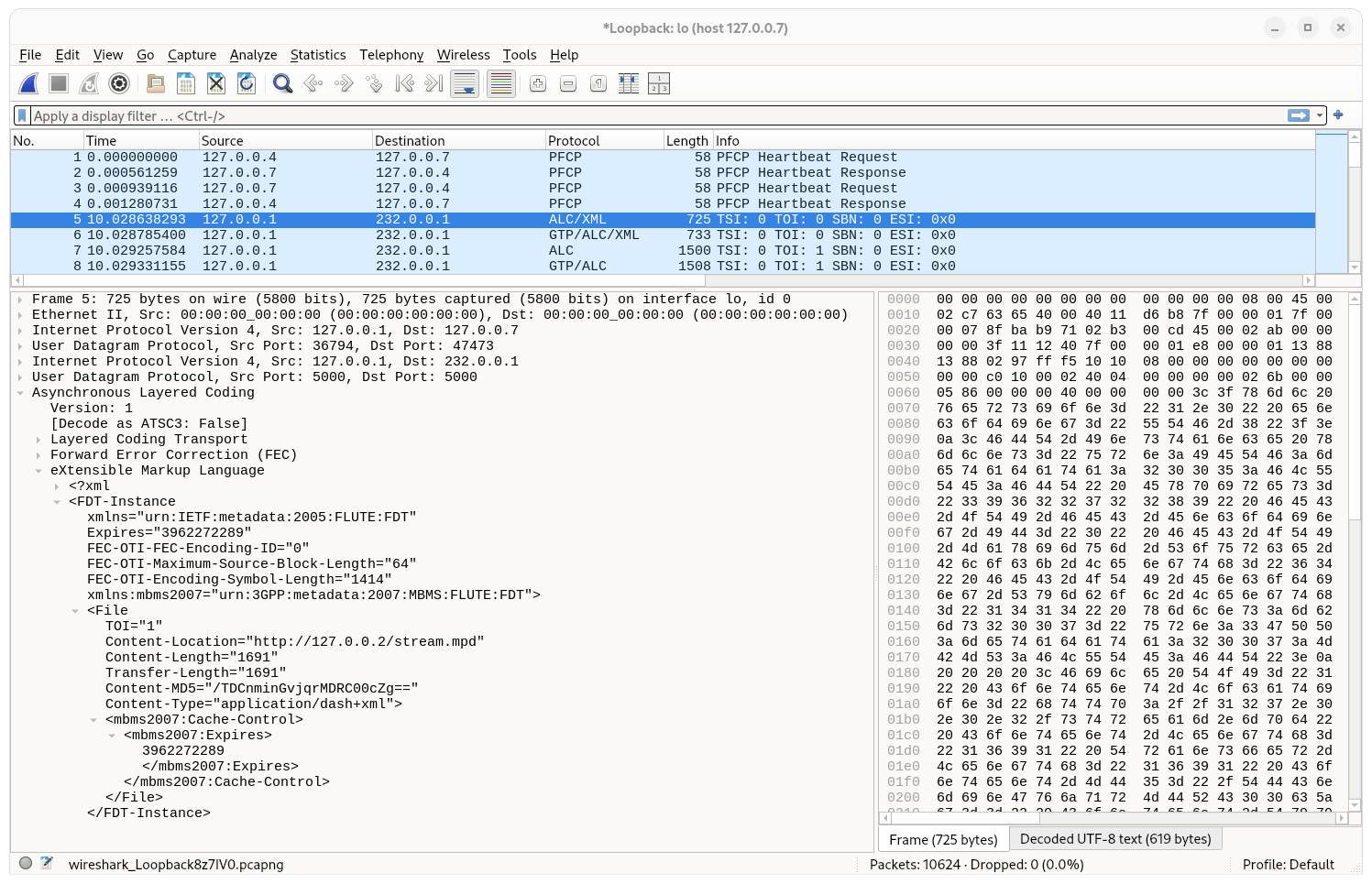
This payload of this packet is a FLUTE transmission object (TOI 0) that conveys the FDT Instance. This document includes a File entry for the MPD transmission object (TOI 1). The objIngestBaseUrl from the Distribution Session configuration has been substituted for the objDistributionBaseUrl in the FDT File entry, resulting in “http://127.0.0.2/stream.mpd” being the advertised path of the MPD file.
The file contents for this example are contained in packets 7 and 9. The screenshot below shows the first packet of the MPD being carried as TOI 1 in the FLUTE stream. Packets 8 and 10 are the MB-UPF forwarding packets 7 and 9 to the gNodeB, encapsulated in a GTP-U tunnel.
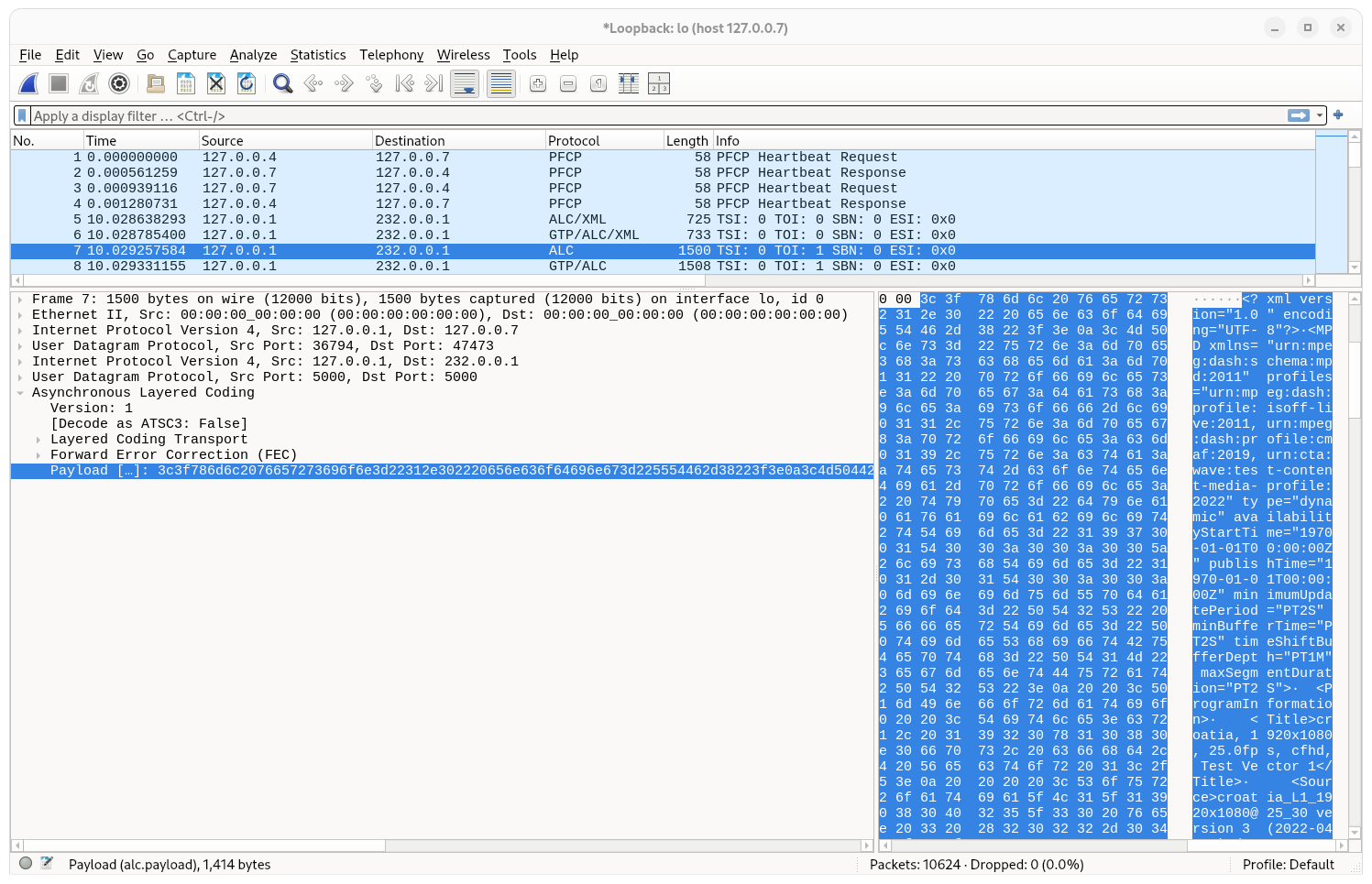
This packet shown in the screenshot below is the File entry in the FDT Instance transmission object (TOI 0) for a DASH initialization segment (with TOI 2). Because this is fetched from the same source as the MPD, the objDistributionBaseUrl substitution happens to this URL too, resulting in the avertised path being “http://127.0.0.2/1/init.mp4”.
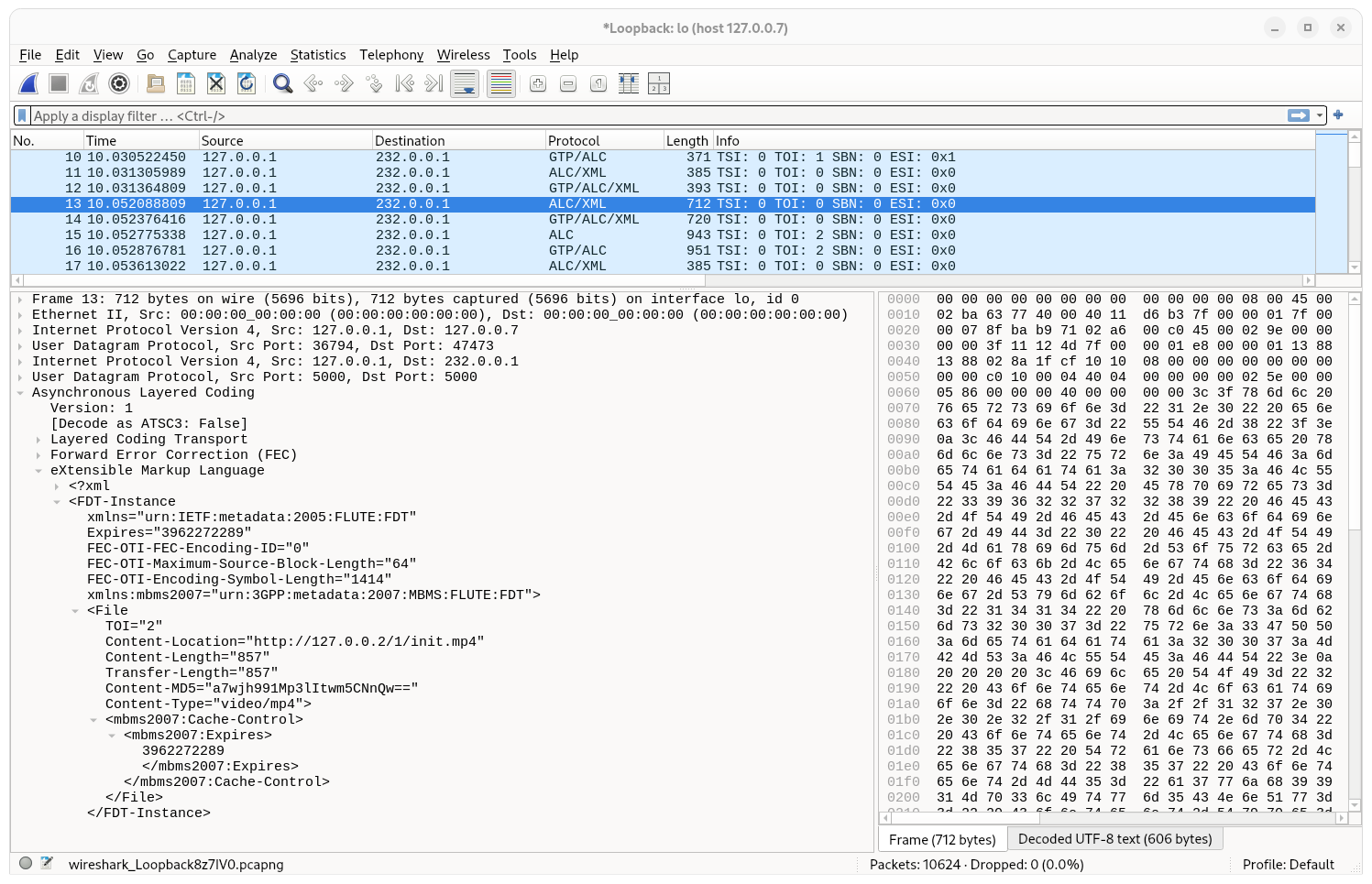
The screenshot below shows the DASH initialization segment being sent in the FLUTE Session as TOI 2.
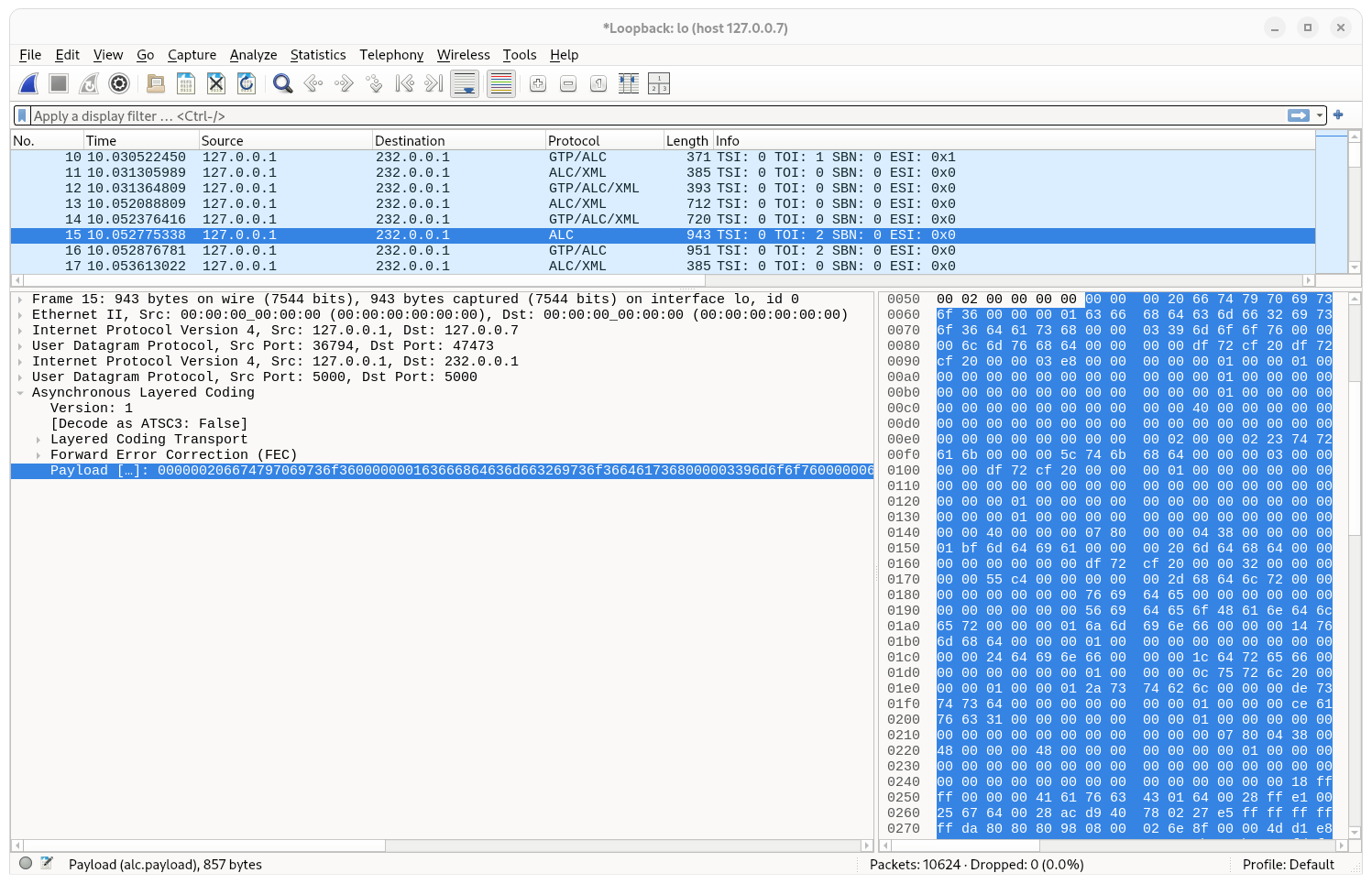
The FDT File entry for the first media segment (TOI=3 in this example FLUTE Session) describes the media segment to be presented as the next live segment in the DASH presentation according to the MPD. This is advertised in the FDT File entry as having a Content-Location value of “http://127.0.0.2/1/876641739.m4s”, as shown in the screenshot below.
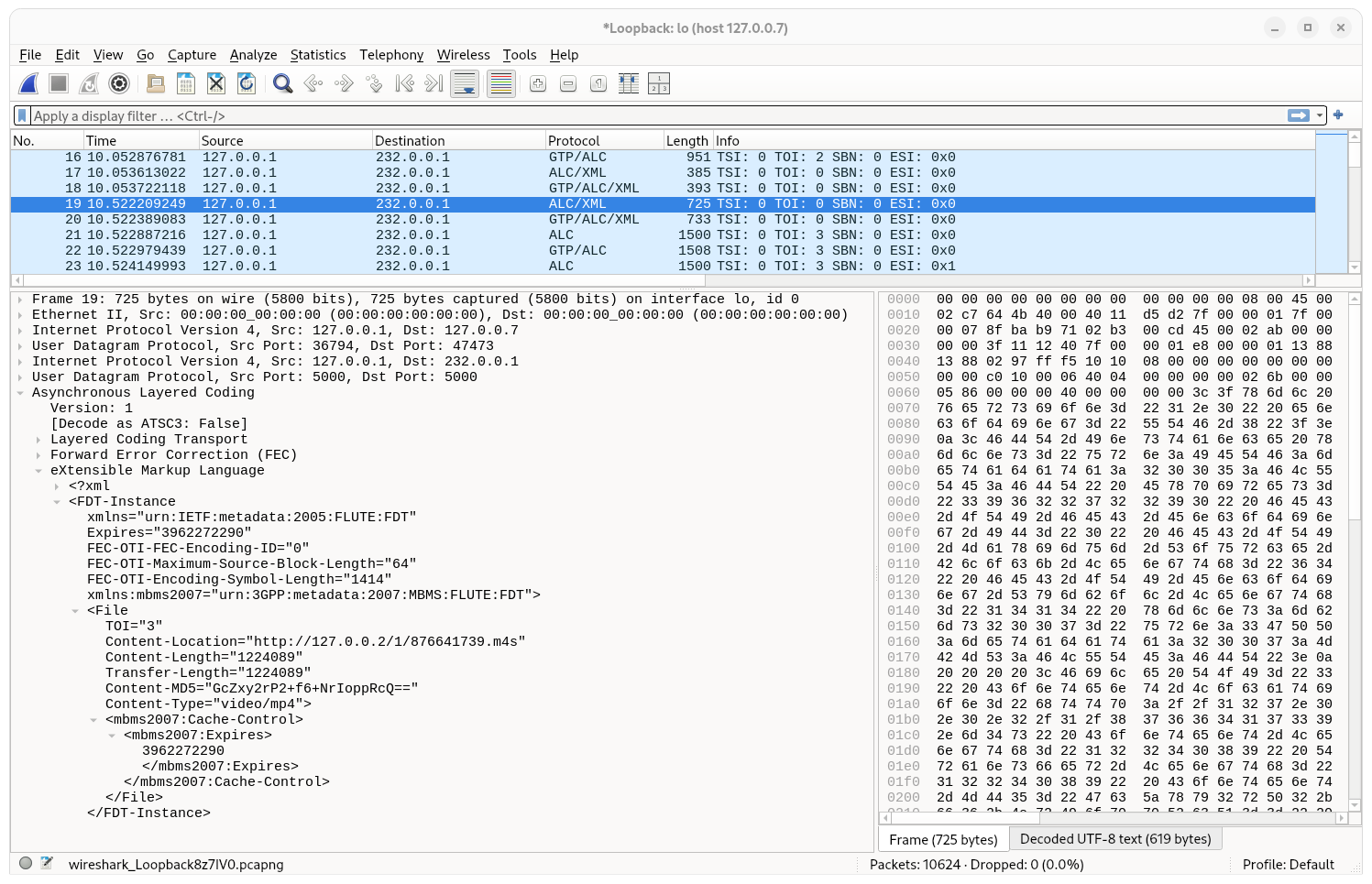
The FDT File entry for the second media segment (TOI=4 in this example FLUTE Session) describes the media segment to be presented as the next live segment one segment duration after the first (just after it became available). This is advertised in the FDT File entry as having a Content-Location value of “http://127.0.0.2/1/876641740.m4s” location, as shown in the screenshot below.

To stop the MBSTF DistSession we can change its state to the INACTIVE state (sequence step 48). This can be done with the following command:
curl -X PATCH --http2-prior-knowledge -H 'Content-Type: application/json-patch+json' --data '[{"op":"replace", "path":"/distSession/distSessionState", "value":"INACTIVE"}]' http://127.0.0.62:7777/nmbstf-distsession/v1/dist-sessions/541ebbd2-ebf9-496b-a3b8-dcd1c17fbc9d
The fetching of new media segements and output of the FLUTE stream will cease and the MBSTF DistSession will return to the INACTIVE state. A new FLUTE stream can now be started by changing the MBS DistSession state to ACTIVE again, if so desired.
Step 7a: (Optional) Destroying the MBS Distribution Session
As the MPD is constantly updated the MBSTF will keep sending MPD, initialization segments and media segments until the process is killed or the MBS distribution session made INACTIVE or destroyed.
To destroy the MBS distribution session run the following command replacing ${distSessionId} in the URL below with the distSessionId you used when pushing the DistSession to the MBSTF.
curl --http2-prior-knowledge -X DELETE http://127.0.0.62:7777/nmbstf-distsession/v1/dist-sessions/${distSessionId}
Based on our example above the REST call looks like this:
curl --http2-prior-knowledge -X DELETE http://127.0.0.62:7777/nmbstf-distsession/v1/dist-sessions/541ebbd2-ebf9-496b-a3b8-dcd1c17fbc9d
Step 8: Create a streaming MBS Distribution Session for push operation on the DASH manifest
This tests the STREAMING distribution mode for PUSHed DASH manifest file (MPD). This executes the following highlighted steps from MBS User Service provisioning using the command line to perform the actions that the MBSF would otherwise perform.
---
title: "MBS User Service Creation: PUSH STREAMING Distribution Session creation on the MBSTF"
config:
themeCSS: |
.loopLine { stroke-width: 4px; stroke-dasharray: 10,5; }
sequence:
showSequenceNumbers: true
---
sequenceDiagram
participant RAN as NG-RAN
participant MBUPF as MB-UPF
participant MBSMF as MB-SMF
participant MBSTF
participant MBSF
participant AP as MBS Application Provider (AF/AS)
activate RAN
activate MBSMF
activate MBUPF
activate MBSF
activate MBSTF
AP ->> MBSF: Add MBS User Data Ingest Session<br/>to MBS User Service
MBSF ->> MBSMF: Create MBS Session<br/>and request an Nmb9 ingress tunnel
MBSMF ->> MBUPF: Set up Multicast/Broadcast service and<br/>create an Nmb9 ingress tunnel
MBUPF -->> MBSMF: Success and Nmb9 ingress tunnel details
MBSMF -->> MBSF: MBS Session created<br/>and Nmb9 ingress tunnel details
rect rgb(160, 255, 160)
MBSF ->> MBSTF: Create Distribution Session<br/>using Nmb9 tunnel details from MB-SMF
MBSTF -->> MBSF: Distribution Session created,<br/>including push Service Entry Point URL,<br/>if requested
end
MBSF -->> AP: MBS User Data Ingest Session created<br/>including push Service Entry Point URL,<br/>if requested
rect rgb(160, 255, 160)
AP ->> MBSTF: DASH manifest
MBSTF -->> AP: DASH manifest received OK
MBSTF ->> MBUPF: DASH manifest packaged in multicast FLUTE session packets<br/>and sent to Nmb9 tunnel at given rate
MBUPF ->> RAN: Multicast FLUTE packets forwarded<br/>to gNodeB(s) via multicast GTP-U tunnel
loop For each initialization segment in the DASH manifest
MBSTF ->> AP: *GET* Initialization Segment
AP -->> MBSTF: Initialization Segment
MBSTF ->> MBUPF: Initialization Segment packaged in multicast FLUTE session packets<br/>and sent to Nmb9 tunnel at given rate
MBUPF ->> RAN: Multicast FLUTE packets forwarded<br/>to gNodeB(s) via multicast GTP-U tunnel
end
par For each Representation in the current period
loop For each Media Segment in the Representation
MBSTF ->> MBSTF: Wait for the Media Segment to become available
MBSTF ->> AP: Pull Media Segment
AP -->> MBSTF: Media Segment delivered
MBSTF ->> MBUPF: Media Segment packaged in multicast FLUTE session packets<br/>and sent to Nmb9 tunnel at given rate
MBUPF ->> RAN: Multicast FLUTE packets forwarded<br/>to gNodeB(s) via multicast GTP-U tunnel
end
end
end
deactivate MBSTF
deactivate MBSF
deactivate MBSMF
deactivate MBUPF
deactivate RAN
This configuration behaves in a similar manner as the PULL STREAMING configuration in Step 7 except that:
- The MPD is the only file whose distribution URL, as given in the Content-Location attribute in the distributed FDT Instance
Fileentry, is subject to substitution with the objDistributionBaseUrl value from the configuration (it is the only file pushed to the objIngestBaseUrl URL prefix). All initialization segments and media segments will be distributed with the Content-Location attribute set to the original media server URL. - The MPD is not automatically refreshed. To refresh, push another MPD to the ingest URL.
With the following processes running:
- the MBSTF from Step 3
- Wireshark from step 4
…perform the following actions to test a streaming distribution from the PUSH of a DASH MPD.
Copy the following into a file called DistSession-DASH-PUSH-request.json:
{
"distSession": {
"distSessionId": "33acd99a-8564-42a1-a96c-9f293d90c41e",
"distSessionState": "ACTIVE",
"mbUpfTunAddr": {
"ipv4Addr": "127.0.0.7",
"portNumber": 5678
},
"upTrafficFlowInfo": {
"destIpAddr": {
"ipv4Addr": "232.0.0.1"
},
"portNumber": 5000
},
"mbr": "10 Mbps",
"objDistributionData": {
"objDistributionOperatingMode": "STREAMING",
"objAcquisitionMethod": "PUSH",
"objAcquisitionIdPush": "manifest.mpd",
"objDistributionBaseUrl": "http://127.0.0.2/"
}
}
}
If you are using the option to use a running MB-SMF/MB-UPF (Step 1a) then make the following changes to the JSON above:
- Change the MB-UPF tunnel IP address
distSession.mbUpfTunAddr.ipv4Addrfrom 127.0.0.7 to the destination IP address for the Nmb9 tunnel returned in the MB-SMF response (sequence step 5). - Change the MB-UPF tunnel port number
distSession.mbUpfTunAddr.portNumberfrom 5678 to the destination port number for the Nmb9 tunnel returned in the MB-SMF response (sequence step 5).
When pushed as a configuration for the MBSTF, this will configure a Distribution Session that will provide an ingest URL and will wait for a Service Entry Point (DASH manifest) document to be PUT to the ingest URL. The ingest URL is the concatenation of objIngestBaseUrl and objAcquisitionIdPush from the response.
Note that the present implementation of the MBSTF only supports live-profile DASH manifests as the Service Entry Point document.
To push the DistSession to the MBSTF to configure it (sequence step 6), use the following command:
curl --http2-prior-knowledge -H 'Content-Type: application/json' --data-binary @DistSession-DASH-PUSH-request.json http://127.0.0.62:7777/nmbstf-distsession/v1/dist-sessions
The MBSTF response (sequence step 7) should look like (the objIngestBaseUrl field will be different):
{
"distSession": {
"distSessionId": "33acd99a-8564-42a1-a96c-9f293d90c41e",
"distSessionState": "ACTIVE",
"objDistributionData": {
"objDistributionOperatingMode": "STREAMING",
"objAcquisitionMethod": "PUSH",
"objAcquisitionIdPush": "manifest.mpd",
"objIngestBaseUrl": "http://127.0.0.1:12345/",
"objDistributionBaseUrl": "http://127.0.0.2/"
}
}
}
In this example response, the ingest URL, formed from objIngestBaseUrl and objAcquisitionIdPush, would be http://127.0.0.1:12345/manifest.mpd. This can be stored in a shell variable for ease of use later:
ingest_url="http://127.0.0.1:12345/manifest.mpd"
The MBSTF will now wait for a live profile DASH MPD to be PUT to the ingest URL (http://127.0.0.1:12345/manifest.mpd from the example) with Content-Type application/dash+xml. We will simulate this push from the AP (sequence step 9).
To push a live-profile MPD we can use the command:
curl -H 'Content-Type: application/dash+xml' -X PUT --data-binary @"${HOME}/rt-mbs-transport-function/tests/tutorial/push-croatia-live.mpd" "${ingest_url}"
Once pushed the MBSTF will add the MPD to the distribution FLUTE stream and proceed to pull the initialization segments and media segments as happened in Step 7 above for the PULL STREAMING Distribution Session.
The Wireshark capture will show that the MPD has a Content-Location in its FDT File entry which is the concatenation of the objDistrubutionBaseUrl and objAcquisitionIdPush. All other objects sent on the FLUTE stream will have Content-Location entries showing a URL from the origin media server. For this example they will all begin with https://livesim2.dashif.org/livesim2/WAVE/vectors/cfhd_sets/12.5_25_50/t1/2022-10-17/.
The following Wireshark screenshot shows the FDT File entry for the MPD with a Content-Location URL of “http://127.0.0.2/manifest.mpd”. This comes from the objDistributionBaseURL concatenated with the objAcquisitionIdPush value.

The next Wireshark screenshot above shows the FDT File entry for the first initialization segment after an MPD has been pushed. Because the MPD included a BaseURL element, directing the rest of the fetches to the original media server, the Content-Location URL is the URL the initialization segment was pulled from.

Step 8a: (Optional) Destroying the MBS Distribution Session
Based on the structure of the MPD (for instance when SegmentTemplate without SegmentTimeline addressing is used) the MBSTF will keep sending initialization segments and media segments until the process is killed or the MBS distribution session is destroyed.
To destroy the MBS distribution session run the following command replacing ${distSessionId} in the URL below with the distSessionId you used when pushing the DistSession to the MBSTF.
curl --http2-prior-knowledge -X DELETE http://127.0.0.62:7777/nmbstf-distsession/v1/dist-sessions/${distSessionId}
Based on our example above the REST call looks like this:
curl --http2-prior-knowledge -X DELETE http://127.0.0.62:7777/nmbstf-distsession/v1/dist-sessions/33acd99a-8564-42a1-a96c-9f293d90c41e